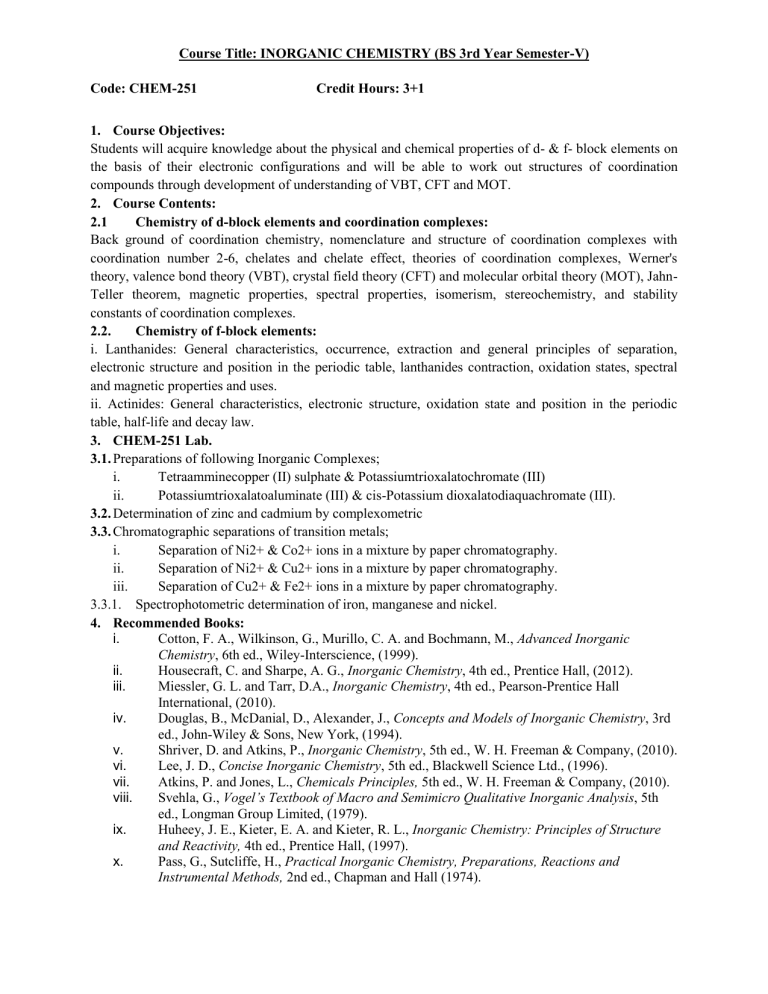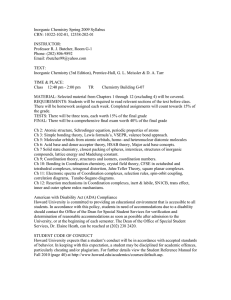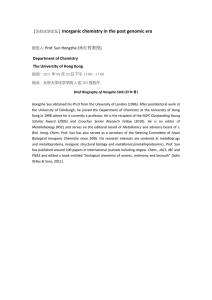
Course Title: INORGANIC CHEMISTRY (BS 3rd Year Semester-V) Code: CHEM-251 Credit Hours: 3+1 1. Course Objectives: Students will acquire knowledge about the physical and chemical properties of d- & f- block elements on the basis of their electronic configurations and will be able to work out structures of coordination compounds through development of understanding of VBT, CFT and MOT. 2. Course Contents: 2.1 Chemistry of d-block elements and coordination complexes: Back ground of coordination chemistry, nomenclature and structure of coordination complexes with coordination number 2-6, chelates and chelate effect, theories of coordination complexes, Werner's theory, valence bond theory (VBT), crystal field theory (CFT) and molecular orbital theory (MOT), JahnTeller theorem, magnetic properties, spectral properties, isomerism, stereochemistry, and stability constants of coordination complexes. 2.2. Chemistry of f-block elements: i. Lanthanides: General characteristics, occurrence, extraction and general principles of separation, electronic structure and position in the periodic table, lanthanides contraction, oxidation states, spectral and magnetic properties and uses. ii. Actinides: General characteristics, electronic structure, oxidation state and position in the periodic table, half-life and decay law. 3. CHEM-251 Lab. 3.1. Preparations of following Inorganic Complexes; i. Tetraamminecopper (II) sulphate & Potassiumtrioxalatochromate (III) ii. Potassiumtrioxalatoaluminate (III) & cis-Potassium dioxalatodiaquachromate (III). 3.2. Determination of zinc and cadmium by complexometric 3.3. Chromatographic separations of transition metals; i. Separation of Ni2+ & Co2+ ions in a mixture by paper chromatography. ii. Separation of Ni2+ & Cu2+ ions in a mixture by paper chromatography. iii. Separation of Cu2+ & Fe2+ ions in a mixture by paper chromatography. 3.3.1. Spectrophotometric determination of iron, manganese and nickel. 4. Recommended Books: i. Cotton, F. A., Wilkinson, G., Murillo, C. A. and Bochmann, M., Advanced Inorganic Chemistry, 6th ed., Wiley-Interscience, (1999). ii. Housecraft, C. and Sharpe, A. G., Inorganic Chemistry, 4th ed., Prentice Hall, (2012). iii. Miessler, G. L. and Tarr, D.A., Inorganic Chemistry, 4th ed., Pearson-Prentice Hall International, (2010). iv. Douglas, B., McDanial, D., Alexander, J., Concepts and Models of Inorganic Chemistry, 3rd ed., John-Wiley & Sons, New York, (1994). v. Shriver, D. and Atkins, P., Inorganic Chemistry, 5th ed., W. H. Freeman & Company, (2010). vi. Lee, J. D., Concise Inorganic Chemistry, 5th ed., Blackwell Science Ltd., (1996). vii. Atkins, P. and Jones, L., Chemicals Principles, 5th ed., W. H. Freeman & Company, (2010). viii. Svehla, G., Vogel’s Textbook of Macro and Semimicro Qualitative Inorganic Analysis, 5th ed., Longman Group Limited, (1979). ix. Huheey, J. E., Kieter, E. A. and Kieter, R. L., Inorganic Chemistry: Principles of Structure and Reactivity, 4th ed., Prentice Hall, (1997). x. Pass, G., Sutcliffe, H., Practical Inorganic Chemistry, Preparations, Reactions and Instrumental Methods, 2nd ed., Chapman and Hall (1974).

